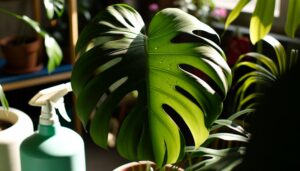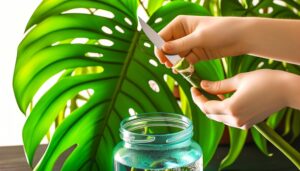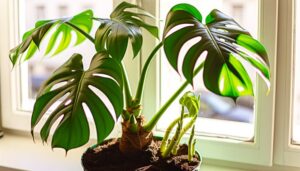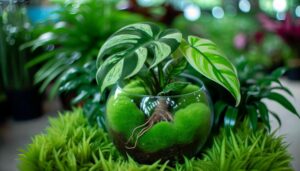Monstera Pinnatipartita Care
To care for your Monstera Pinnatipartita, place it in bright, indirect light, avoiding direct sunlight to prevent leaf burn. Water when the top inch of soil is dry, usually weekly in the growing season and biweekly during dormancy.
Choose a well-draining soil mix with coco coir, perlite, and compost, and confirm your pot has drainage holes. Maintain temperatures between 65-80°F and humidity levels between 60-80%, using a hygrometer to monitor.
Fertilize bi-monthly with a diluted 20-20-20 N-P-K ratio during the growing season, and reduce in winter. Explore more to uncover finer details and advanced tips.
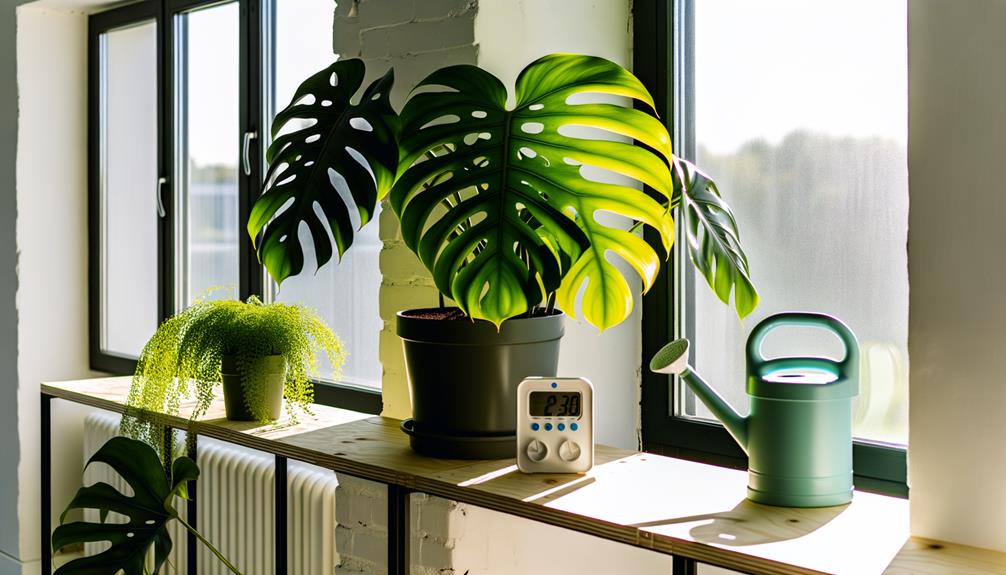
Key Takeaways
- Place Monstera Pinnatipartita in bright, indirect light to mimic its natural habitat.
- Water when the top inch of soil is dry, avoiding overwatering to prevent root rot.
- Use a well-draining soil mix with coco coir, perlite, and compost.
- Maintain a temperature range of 65-80°F and humidity levels between 60-80%.
- Fertilize bi-monthly with a balanced, water-soluble fertilizer diluted to half strength during the growing season.
Light Requirements
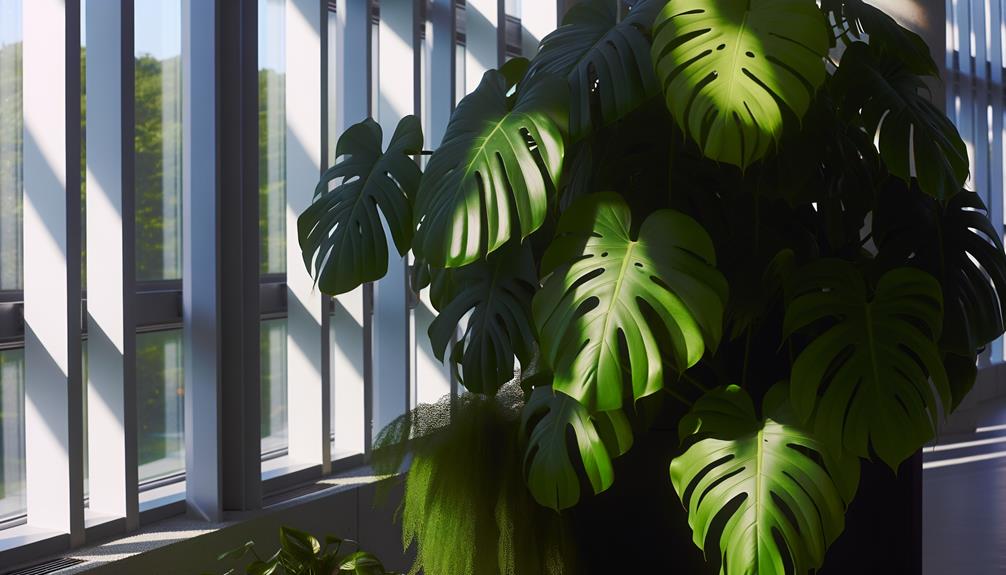
To maximize growth, place your Monstera Pinnatipartita in bright, indirect light. This plant thrives under conditions that mimic its natural habitat, where sunlight filters through forest canopies. Direct sunlight can cause photodamage, leading to leaf burn.
Position your plant near an east-facing window or a few feet away from a south or west-facing window, guaranteeing diffused light. If natural light is insufficient, use full-spectrum LED grow lights, maintaining a 12-14 hour photoperiod.
Monitor the leaves for signs of light stress; yellowing may indicate excessive light, while dark green, slow-growing leaves suggest insufficient light. Rotate the plant periodically to secure even light distribution, promoting symmetrical growth.
Consistent lighting conditions will support its photosynthetic efficiency and overall health.
Watering Schedule
To maintain peak health for your Monstera Pinnatipartita, water it once the top inch of soil feels dry, typically every 1-2 weeks.
Overwatering can lead to root rot, indicated by yellowing leaves and a musty odor. Secure proper drainage and adjust the frequency based on seasonal changes and indoor humidity levels.
Ideal Watering Frequency
Water your Monstera Pinnatipartita when the top 2-3 inches of soil feel dry to the touch, ensuring the plant receives adequate hydration without becoming waterlogged. Insert your finger into the soil to gauge its moisture level. If dry, use tepid, dechlorinated water to hydrate the plant thoroughly, allowing excess water to drain from the bottom. This prevents root rot and promotes healthy growth.
Generally, during the active growing season (spring and summer), water approximately once a week. In the dormant period (fall and winter), reduce frequency to biweekly or when soil dryness is evident. Consistent monitoring and adjustment based on environmental factors like temperature and humidity will optimize your Monstera Pinnatipartita's health and essentiality.
Signs of Overwatering
Ensuring your Monstera Pinnatipartita remains healthy involves recognizing signs of overwatering, such as yellowing leaves, mushy stems, and a musty odor around the soil. When you detect these symptoms, immediately reduce watering frequency.
Check soil moisture levels using a hygrometer or by inserting your finger into the soil up to the second knuckle. The top 2-3 inches should dry out between waterings.
Improve drainage by ensuring the pot has adequate holes and using well-draining soil mixtures. If roots appear brown and slimy, root rot might've set in; trim affected roots and repot the plant in fresh soil.
Soil and Potting
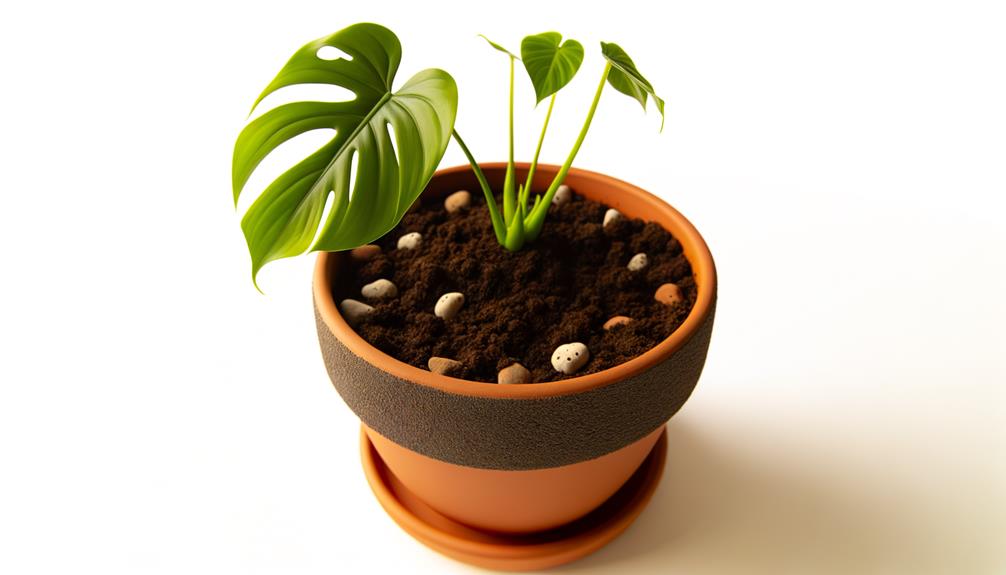
When potting your Monstera Pinnatipartita, select a well-draining soil mix rich in organic matter to support its vigorous growth and prevent root rot. This plant flourishes in a mix that balances aeration and moisture retention. To achieve this, consider the following components:
- Coco coir or peat moss: These materials retain moisture without becoming waterlogged, providing an excellent base.
- Perlite or pumice: These inorganic amendments enhance drainage and aeration, preventing soil compaction.
- Compost or worm castings: These organic additives supply essential nutrients, promoting robust growth.
Guarantee your pot has drainage holes to prevent water accumulation. Repot every 1-2 years, gradually increasing pot size to accommodate growth. This method will secure a healthy, thriving Monstera Pinnatipartita.
Temperature and Humidity
Maintaining an ideal temperature range of 65-80°F (18-27°C) is crucial for the Monstera Pinnatipartita's growth and overall health. You should avoid placing the plant in areas where temperatures drop below 55°F (13°C) as cold stress can hinder its metabolic processes.
Additionally, aim to maintain humidity levels between 60-80%. Utilize a hygrometer to monitor ambient humidity and use a humidifier if necessary. To increase localized humidity, consider placing a pebble tray filled with water underneath the plant's pot.
Avoid sudden temperature fluctuations and drafts, as these can lead to foliar damage. Consistent monitoring and adjustments will guarantee the Monstera Pinnatipartita thrives in its environment, promoting vigorous growth and vibrant foliage.
Fertilization Tips
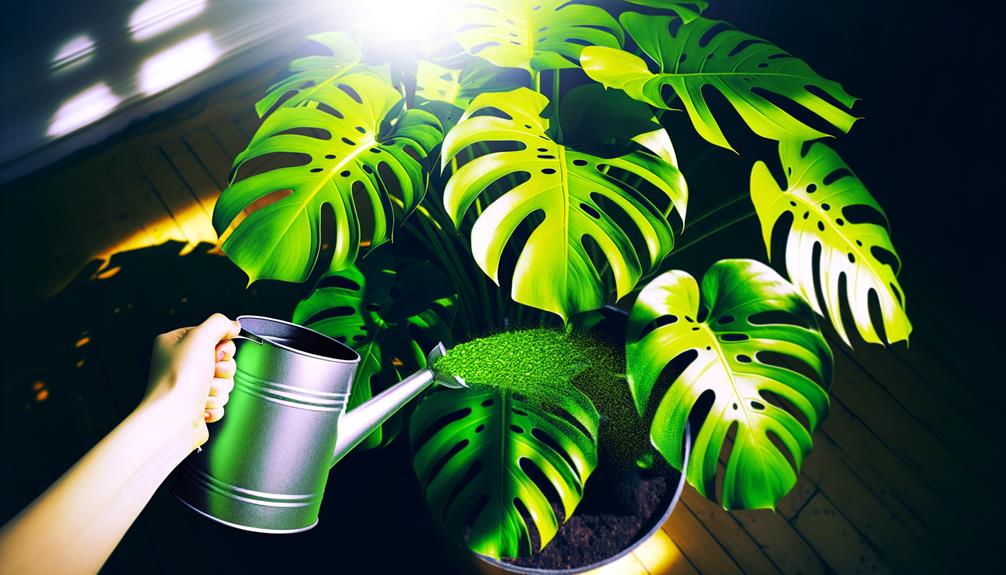
You'll need to select a balanced, water-soluble fertilizer to guarantee your Monstera Pinnatipartita receives essential nutrients.
Apply the fertilizer bi-monthly during the growing season, typically from spring through early autumn.
Reduce feeding to once every two months in the dormant winter period to avoid nutrient buildup.
Optimal Fertilizer Types
Selecting the best fertilizer for Monstera Pinnatipartita involves understanding its nutrient needs and choosing a balanced formula with a ratio of 20-20-20 or similar. This guarantees your plant receives equal parts nitrogen, phosphorus, and potassium, essential for robust growth.
When applying fertilizer, consider these steps:
- Dilution: Mix the fertilizer at half the recommended strength to avoid nutrient burn, ensuring a gentle yet effective feed.
- Application: Apply the diluted solution every four weeks during the growing season, targeting the soil rather than the foliage.
- Observation: Monitor the plant for signs of over-fertilization like leaf burn or under-fertilization such as slow growth, adjusting the dosage as needed.
Seasonal Feeding Schedule
To make sure your Monstera Pinnatipartita thrives, following a seasonal feeding schedule tailored to its growth cycle is crucial. During the active growing season, typically spring through early autumn, apply a balanced, water-soluble fertilizer with an N-P-K ratio of 20-20-20 every two weeks. Dilute the fertilizer to half the recommended strength to prevent nutrient burn.
In late autumn and winter, reduce feeding frequency to once a month, using a diluted solution to match the plant's slowed metabolic rate. Avoid fertilizing if the plant appears stressed or during dormancy.
Consistent monitoring of soil pH (ideally 5.5-7.0) ensures nutrient uptake efficiency. By adhering to this specific schedule, you'll promote robust growth and vibrant foliage.
Propagation Methods
Propagating Monstera Pinnatipartita can be effectively achieved through stem cuttings. This involves selecting a healthy parent plant and making precise cuts just below a node. Make certain the cutting has at least one node and a couple of leaves.
Follow these steps:
- Prepare the Cutting: Use sterilized shears to make a clean cut below a node. Remove any lower leaves to expose the node.
- Rooting Medium: Place the cutting in water or a well-draining soil mix. Maintain high humidity by covering it with a plastic bag.
- Monitor Growth: Position the cutting in indirect sunlight. Change water weekly if propagating in water, or keep the soil moist but not soggy if using soil.
This method guarantees healthy root development.
Conclusion
To sum up, caring for your Monstera pinnatipartita is a breeze—if you enjoy the challenge of balancing light, water, soil, temperature, humidity, and fertilization like a scientist in a botany lab.
Propagation? Just a simple matter of mastering stem cuttings and node placements.
Follow these 'easy' steps, and you'll have a thriving plant that rivals any rainforest specimen.
Who knew being a plant parent required a degree in horticultural sciences?
Happy growing!

